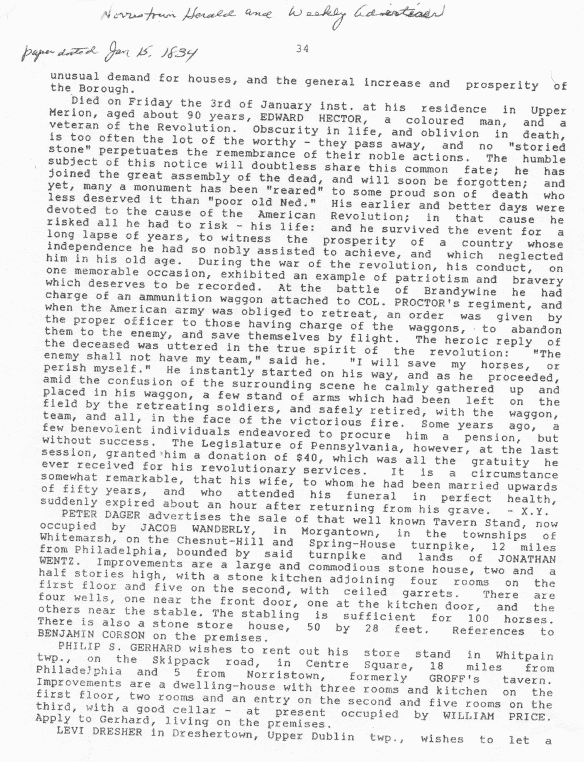


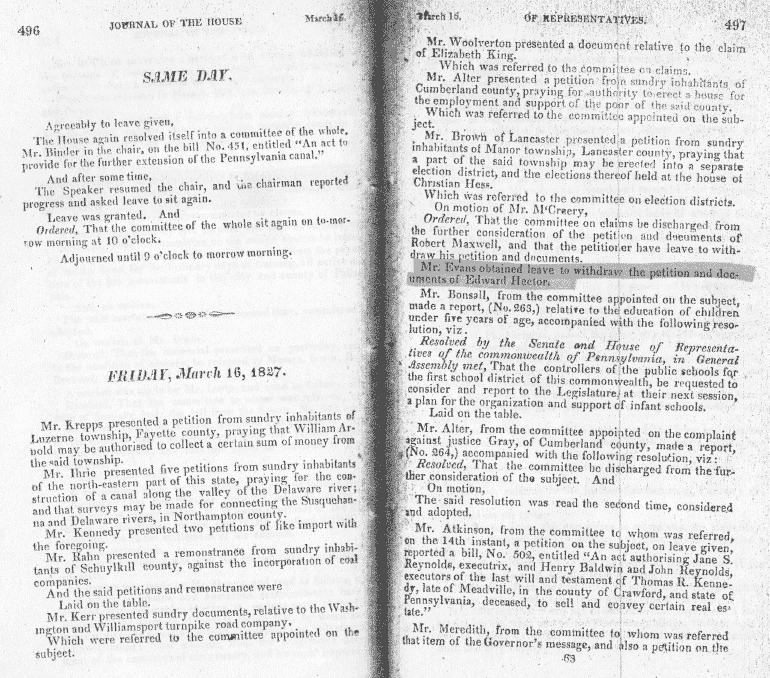




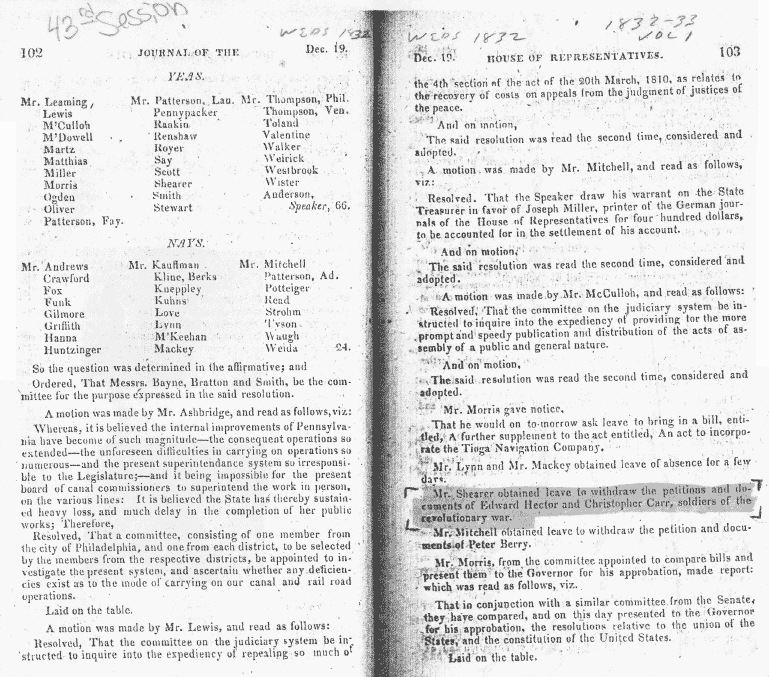
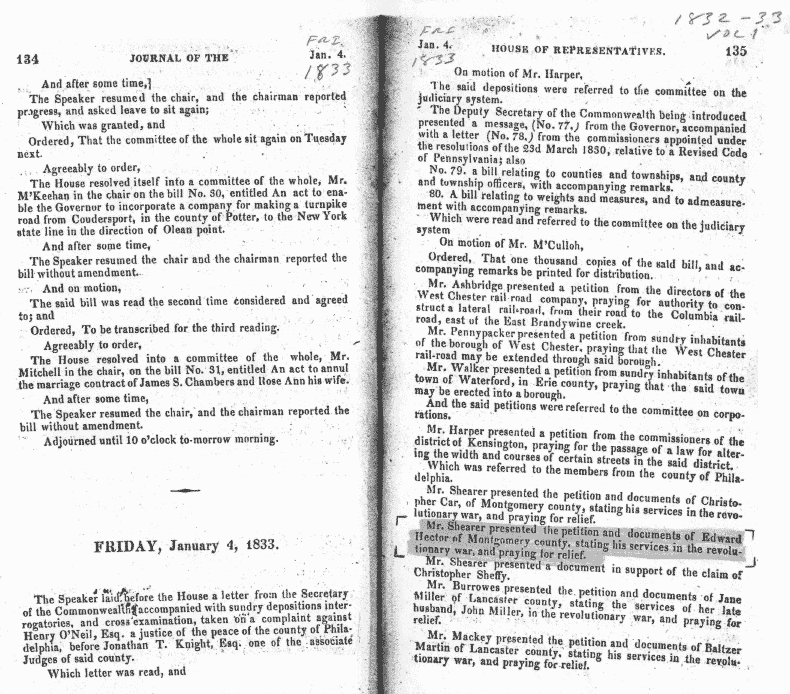




Report from Claims Committee to Pennsylvania House of Representatives as found in Pa Journal of the House of Representatives
“No. 218
Report of the committee on claims, on the claim of Edward Hector, a revolutionary soldier.
READ February 16, 1827
Mr. McCreery, from the committee on claims, to whom were referred the petition and documents of Edward Hector, made the following report, which was read, viz:
That the petitioner states that he was employed in driving; an artillery waggon, attached to the regiment commanded by col. Proctor. That he was present at the battles of Brandywine and Germantown, and that he never received any compensation for his services. He therefore prays the Legislature to take his case into consideration, and grant him such relief as they may think proper.
Your committee bed leave to remark, that there is no evidence before them, that any thing is due to the petitioner; neither is there any testimony, except his own statement and deposition, how long he did serve, or what kind of service he rendered. There is the deposition of Thomas R. Brooks, stating that he was well acquainted with the petitioner, and knows that he was in the army; but does not say what length of time, nor in what capacity, he served. Your committee would further remark, that if the statements of the petitioner were fully substantiated, they would not consider him entitled to a pension, agreeably to the practice of the Legislature hitherto. They therefore offer the following resolution:
Resolved, That the committee be discharged from any further consideration of the subject.”




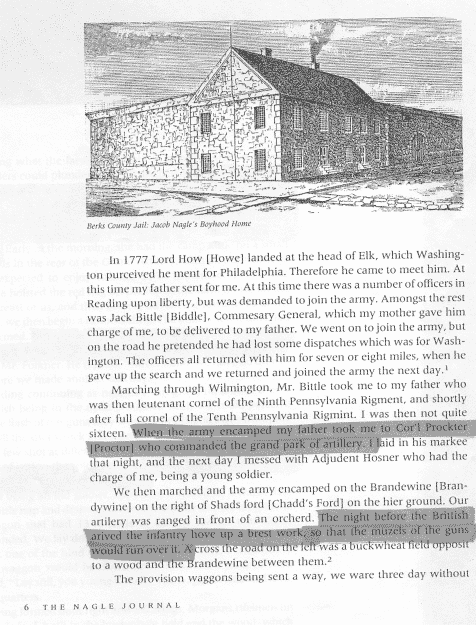

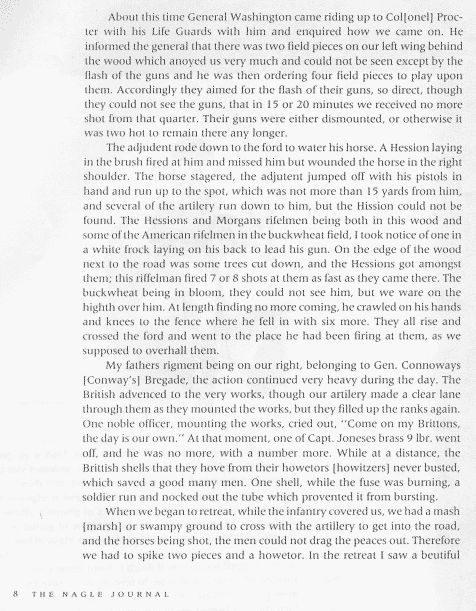


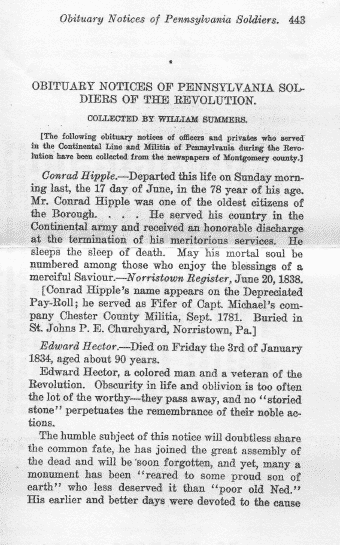
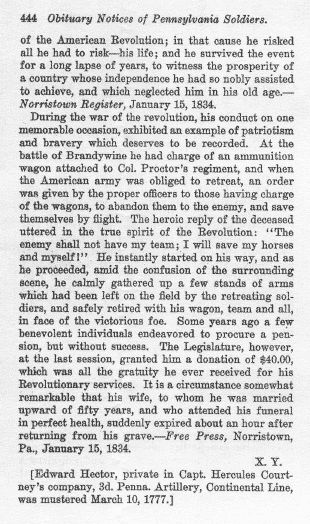

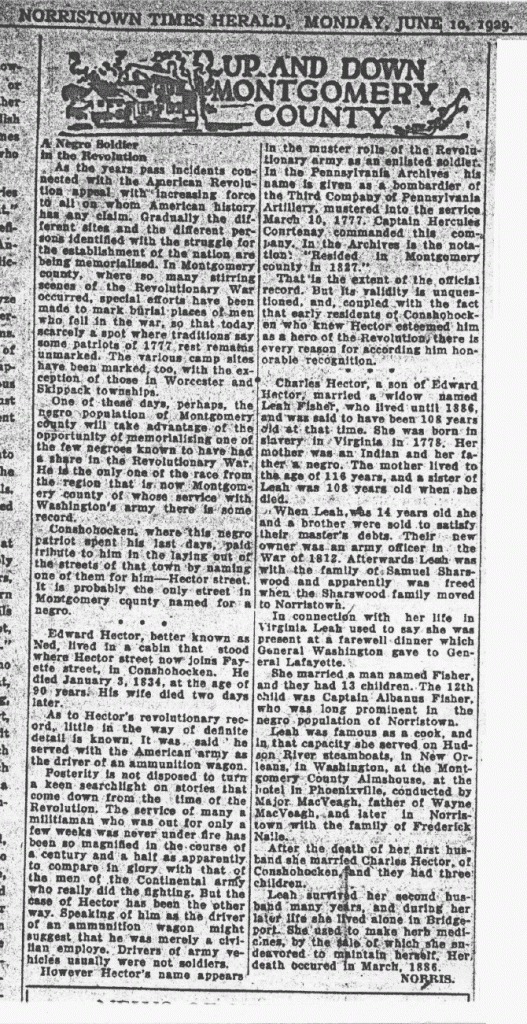


Edward Hector
By Noah Lewis
From Wikipedia, the free encyclopedia



Introduction
Edward “Ned” Hector (born about 1744) was an African American soldier who fought in the American Revolutionary War. Hector was one of three to five thousand people of color that fought for the cause of American independence.[1][2] He served as a teamster (a wagon driver)[3][4] and a bombardier (part of an artillery crew) with the state militia called Proctor’s Third Pennsylvania Artillery,[5] which by the end of 1777 became the Fourth Continental Artillery.[6] The known battles he participated in are the Battle of Brandywine (September 11, 1777) and Germantown (October 4, 1777).[7] In the Battle of Brandywine he disregarded his orders to abandon everything and retreat. He is remembered for replying to the orders, “The enemy shall not have my team; I will save my horses and myself!”[8]
Contents
1 Military – American Revolutionary War
2 Life and family
3 Burial
4 Related Information
5 References
Military – American Revolutionary War
The first time Edward Hector is mentioned is on the muster rolls of February 1–28, 1777 for Colonel Proctor’s 3rd Pennsylvania Artillery. Confirmed on March 10, 1777,[9] he is listed as a bombardier. A bombardier is one of the three rear positions of the cannon.[10] There exist a belief that African American, like Hector, did not serve as fighting men in the army. This view holds that African American served only as slaves and manual labor. The records tell us differently. Not only did African American fight for America, but also for Britain as well. It is estimated that one hundred thousand people of color decided to served Britain.[11][12] it was cited his “heroic” action, in a situation where Hector could have honorably obeyed orders to retreat; he demonstrated “bravery” by saving his wagon, horses, supplies, and discarded guns.[8] This is in stark contrast to Hector’s commanding officer, whom was court-martialed for leaving the battle in an “un-officer way”.[13] Among the military records it was listed that Hector had four horses and a wagon as personal property.[14][15] This indicates that Edward Hector was a free man, since a substitute slave was considered property and what they owned belonged to their master. The records indicates Edward Hector served in the military from February 1777, according to the muster roll, to at least December of 1780. Although The Pennsylvania House of Representative’s report 218 mentions that Hector’s pension application, “does not say what length of time, nor in what capacity, he served” Hector’s activities as a teamster in the military was documented as the following; On November 30, 1778, “Negro Hector” is expressing or delivering something to “Fredrickbaugh.”[16] There was in addition, a reference to a “Negro Nedd” working with a Matthew Brook on April 20, 1780.[17] On May 22, 1780, “Ned Hector” was transporting pig metal for the artillery military stores for Colonel Potts,[18] on December 5, 1780 “Negro Ned” delivered 1 ton of Andover pig metal for George Brook, and again on December 14, 1780 “Negro Ned” was transporting forty-two ten inch shells from Rutters and Potts Furnace for Colonel Potts with M. Brooks.[19] Edward Hector applied for his pension in 1827.[20] When report number 218 is given by the Committee on Claims to the Pennsylvania House of Representatives, his application was rejected.[21] He reapplied in 1829,[22] and 1833.[23] Finally, in 1833 the Pennsylvania Congress voted to give Hector the one time “gratuity” of forty dollars.[8]
Life and Family
After the war he showed up on the 1800 census in Plymouth Township, Montgomery County, PA.[24][25] This area became the Borough of Conshohocken in 1850. According to the 1800 Federal Census, he is one of the first African American to settle in this area. As an active part of his community, he paid taxes from 1811 to 1825 for dogs and a cow.[26] He died on Jan.5, 1834, at the age of 90. His wife, during the process of the interment of her husband, also died.[8] Edward Hector struggled with the social problems of his times. There is a court file recording Edward Hector being robbed of a “scythe and hangings” by James Brown in 1808. Edward Hector was one of the earliest African American to live as a free black person in Plymouth Township, Pennsylvania (later to become Conshohocken) and was one of the earliest people to move into this area.[27] Hector is remembered in 1850, sixteen years after his death, by the people of the newly formed Conshohocken area. Thirty-two citizens petition the borough council to develop and grade a road passable to wagons and name it Hector Street, to honor this man of African ancestry.[28] In 1976, a historical plaque is erected at the intersection of Hector and Fayette Street honoring Ned and the many Africans that served during the American Revolution.[29][30]


From the obituary, it is learned that Hector had been married about fifty years. This would have Hector marrying about 1784, at the age of 40. The History of Montgomery County records Jude as his wife.[31][32]
Burial
A researcher for the Historical Society of Montgomery County, Barton B. Proger, reported a gravestone with “E.H.” on it in the Robert’s Cemetery in Bridgeport, PA.[30][33][34]
Related Information
www.nedhector.com [35]
Greene, Robert Ewell Black Courage 1775-1783
Davis, Burke Black Heroes of the American Revolution
Schama, Simon Rough Crossings
Trussell, John B. B. The Pennsylvania Line, Regimental Organization and Operation 1776-1783
Mazyck, Walter H. George Washington and the Negro
Selig, Robert A. The Revolution’s Black Soldier
Drotning, Phillip Black Heroes in Our Nation’s History
Blockson, Charles Black Genealogy
Blockson, Charles African Americans in Pennsylvania
Cox, Clinton Come All You Brave Soldiers
Becton, Joseph W. The Black Regiment and the Defense of Philadelphia
References
1.^ Grundset, Eric G., Forgotten Patriots, National Society Daughters of the American Revolution, (2008), pages 703 – 707
2.^ Lewis, Noah Being Edward Hector – The Life and Times of a Black Revolutionary War Hero Bulletin of the Historical Society of Montgomery County Pennsylvania, Historical Society of Montgomery County, (1913) Vol.XXXVI, No.4, page 19
3.^ Reist, Arthur The Conestoga Wagon-Masterpiece of the Blacksmith p.49;
4.^ Rees, John U. Wagons and Watercraft During the War for Independence
5.^ Pennsylvania Archives – 5th series – vol.#3, page 1054-1057
6.^ Trussell, John B. B. The Pennsylvania Line: Regimental Organization and Operations, 1775-1783 page 205
7.^ The Journal of the (Pennsylvania) House of Representatives, 1826-1827, p.493-494, Report #218 “Report of the committee on claims, on the claim of Edward Hector, a revolutionary soldier. READ February 16, 1827 Mr. McCreery, from the committee on claims, to whom were referred the petition and documents of Edward Hector, made the following report, which was read, viz: That the petitioner states that he was employed in driving; an artillery waggon, attached to the regiment commanded by col. Proctor. That he was present at the battles of Brandywine and Germantown, and that he never received any compensation for his services. He therefore prays the Legislature to take his case into consideration, and grant him such relief as they may think proper. Your committee bed leave to remark, that there is no evidence before them, that anything is due to the petitioner; neither is there any testimony, except his own statement and deposition, how long he did serve, or what kind of service he rendered. There is the deposition of Thomas R. Brooks, stating that he was well acquainted with the petitioner, and knows that he was in the army; but does not say what length of time, nor in what capacity, he served. Your committee would further remark, that if the statements of the petitioner were fully substantiated, they would not consider him entitled to a pension, agreeably to the practice of the Legislature hitherto. They therefore offer the following resolution: Resolved, That the committee be discharged from any further consideration of the subject.”
8.^ a b c d Sommers, William Pennsylvania Magazine – “Obituary Notices of Pennsylvania Soldiers” p.443-444
9.^ Pennsylvania Archives – 5th series – vol.3 page 1054-1057
10.^ Caruana, Adrian The Light 6-Pdr. Battalion Gun of 1776
11.^ Quarles, Benjamin The Negro in the American Revolution (1961), page 119, 134-157
12.^ Schama, Simon Rough Crossings: Britain, the Slaves and the American Revolution page 8
13.^ Valley Forge Orderly Book of General George Weedon of the Continental Army The New York Times & Arno Press, page 177
14.^ Records of the Comptroller General Military Accounts Line, 1775 to 1809, Fourth Continental Artillery, David Library of the American Revolution, microfilm record RG4 #386
15.^ Lewis, Noah Being Edward Hector – The Life and Times of a Black Revolutionary War Hero Bulletin of the Historical Society of Montgomery County Pennsylvania, Historical Society of Montgomery County, (1913) Vol.XXXVI, No.4, page 20
16.^ Papers of the Continental Congress, compiled 1774-1789, NARA M247, item number 173, volume 3, page 185
17.^ Pine Forge Ledger, Pennsylvania Historical Society, April 20, 1780
18.^ Records of Military Stores Received and Delivered at Philadelphia, March 1780-July 1783, microfilm M853, roll #37, volume 133, page 47
19.^ Records of Military Stores Received and Delivered at Philadelphia, March 1780-July 1783, microfilm M853, roll #37, volume 133, page 186
20.^ Journal of the (Pennsylvania) House of Representatives 1826-27 Session, Vol.1, page 853
21.^ Journal of the (Pennsylvania) House of Representatives, 1826-1827, p.493-494, Report #218
22.^ Journal of the (Pennsylvania) House of Representatives 1828-29 Session, Vol.1, page 833
23.^ Journal of the (Pennsylvania) House of Representatives 1832-33 Session, Vol.1, page 135
24.^ 1800 Federal Census, Plymouth Township, Montgomery Co. PA
25.^ Lewis, Noah Being Edward Hector – The Life and Times of a Black Revolutionary War Hero Bulletin of the Historical Society of Montgomery County Pennsylvania, Historical Society of Montgomery County, (1913) Vol.XXXVI, No.4, page 27
26.^ Montgomery County Tax records for 1831 and 1833
27.^ Court of Quarter Sessions in Montgomery Co. Nov. Session, November 13, 1804
28.^ Conshohocken business minutes 1850 – 1854 Conshohocken Library
29.^ Blockson, Charles L. A Brief History of the Pennsylvania Black History Committee
30.^ a b Lewis, Noah Being Edward Hector – The Life and Times of a Black Revolutionary War Hero Bulletin of the Historical Society of Montgomery County Pennsylvania, Historical Society of Montgomery County, (1913) Vol.XXXVI, No.4, page 30
31.^ Bean, Theodore History of Montgomery County , Chapter XLI. Borough of Conshohocken, page 717
32.^ Lewis, Noah Being Edward Hector – The Life and Times of a Black Revolutionary War Hero Bulletin of the Historical Society of Montgomery County Pennsylvania, Historical Society of Montgomery County, (1913) Vol.XXXVI, No.4, page 29
33.^ Proger, Barton B. Tomestone Transcriptions – Roberts Burial Ground (Red Hill) Upper Merion Township, Montgomery County, Pa. , Historical Society of Montgomery County
34.^ What information presently known about Hector’s burial is, he may have been buried in the Mt Zion AME Church located at Lafayette and Chain Street in Norristown, PA. The following reasons are; First, Hector’s step-grandchild Albanus Fisher is on the board of trustees of this church. Second, Hector’s son, Isaac Hector, is living in Norristown at the time of Hector’s death. Third, this is one of very few places where people of African descent were allowed to be buried. Lastly, oral history comes from a respected and knowledgeable historian from the Norristown area named Charles Blockson. It is possible his body was removed from Mt Zion, along with 190 other Africans, to the Roberts Cemetery in Bridgeport, PA. This is the burial ground that Charles Blockson remembers he was taken to as a child and was told Edward Hector was buried in.
35.^ http://www.nedhector.com
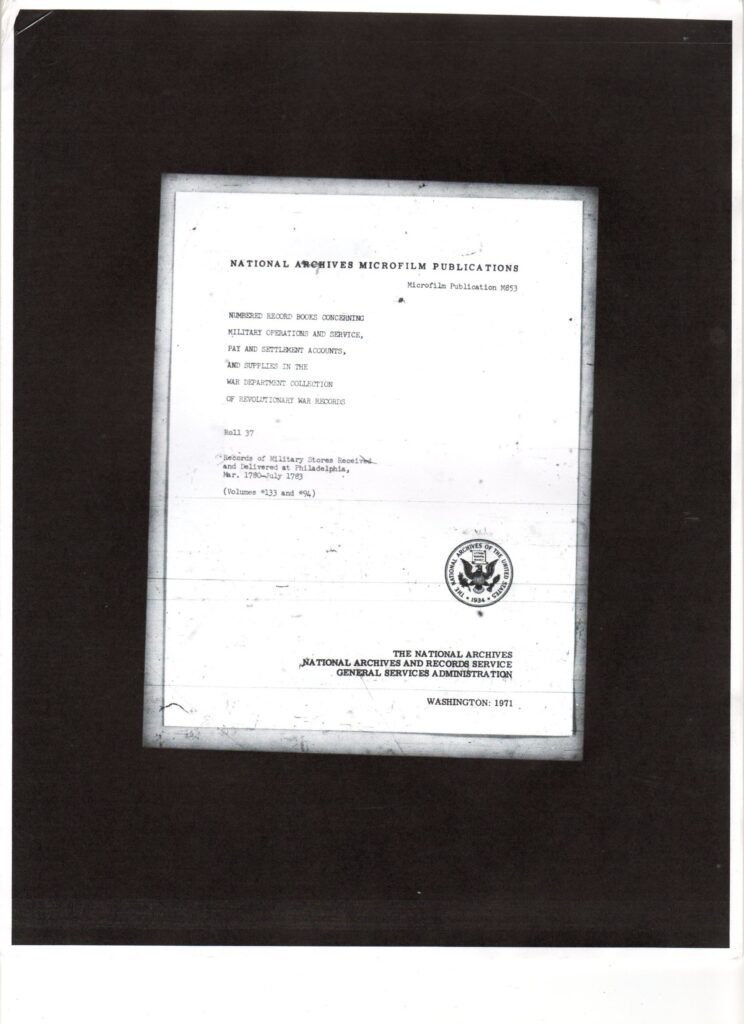







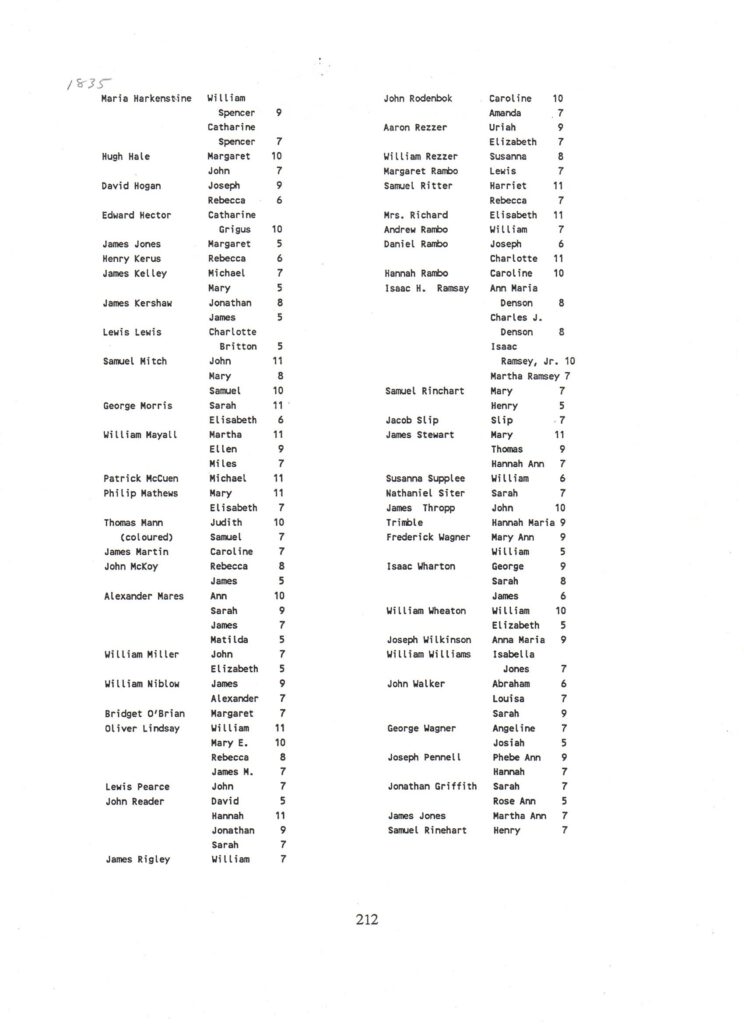



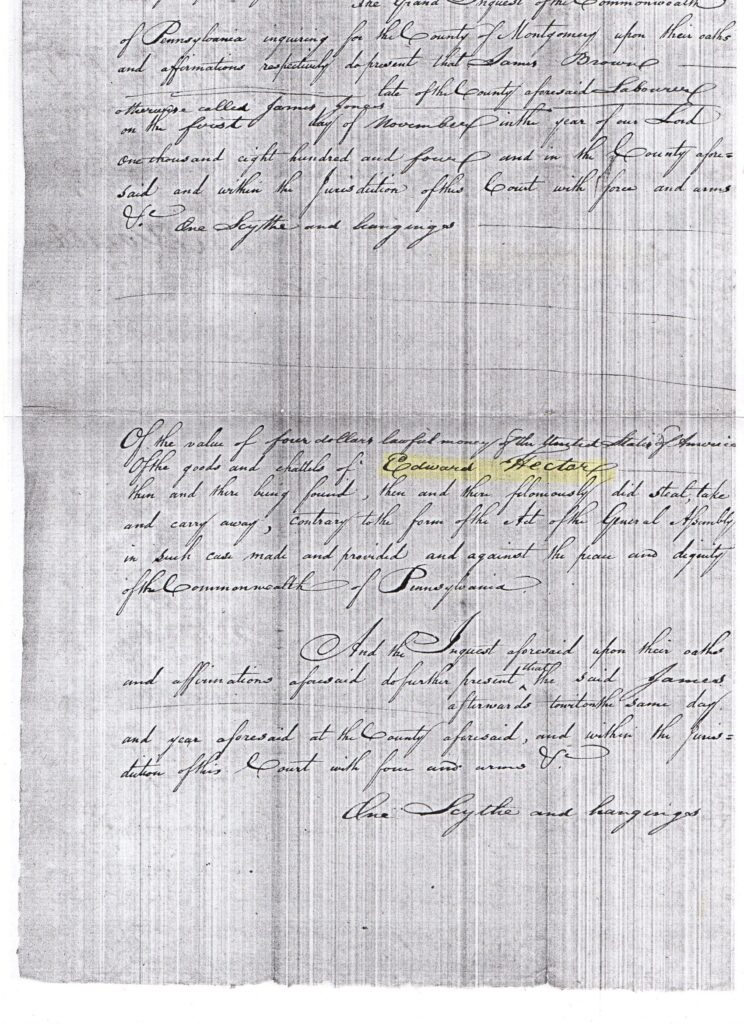


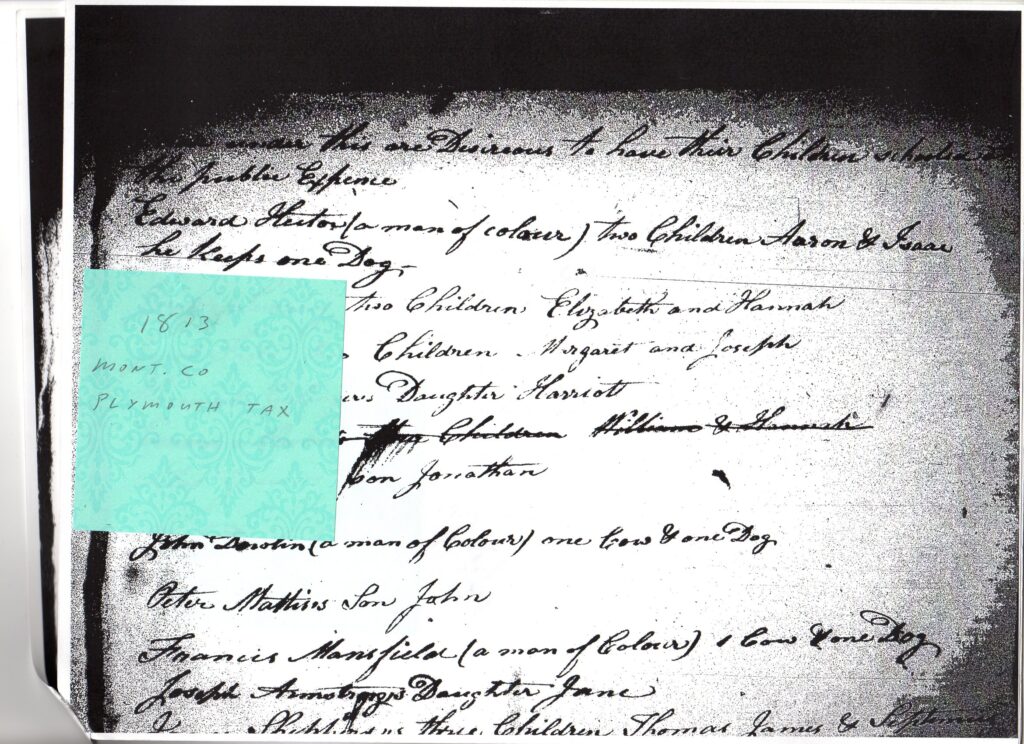





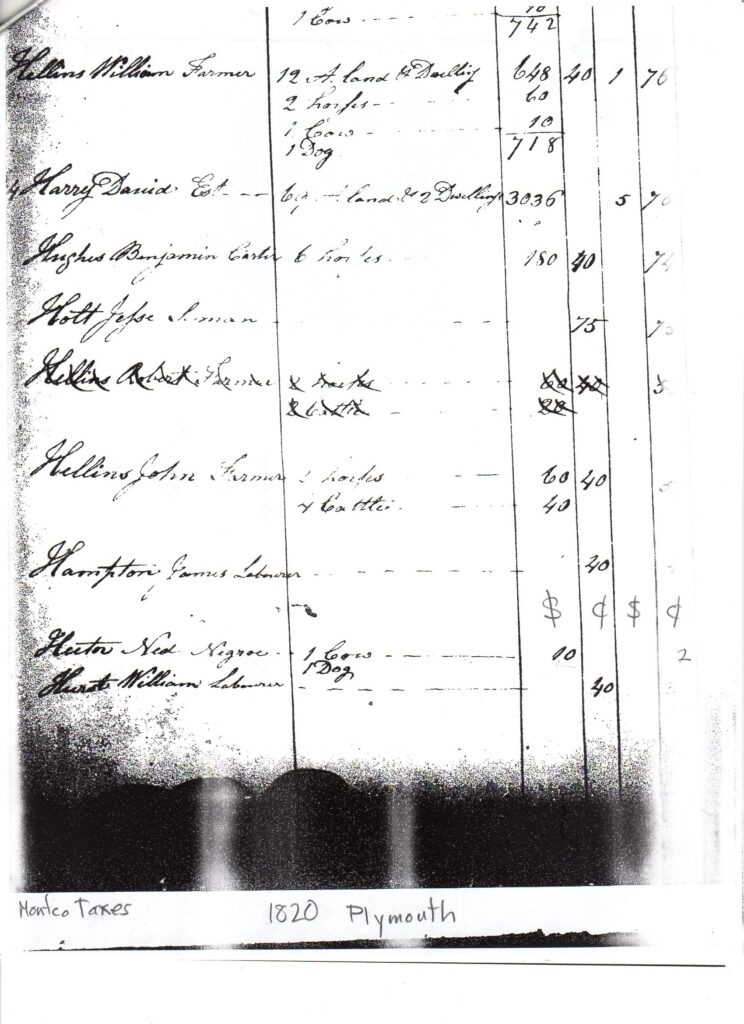
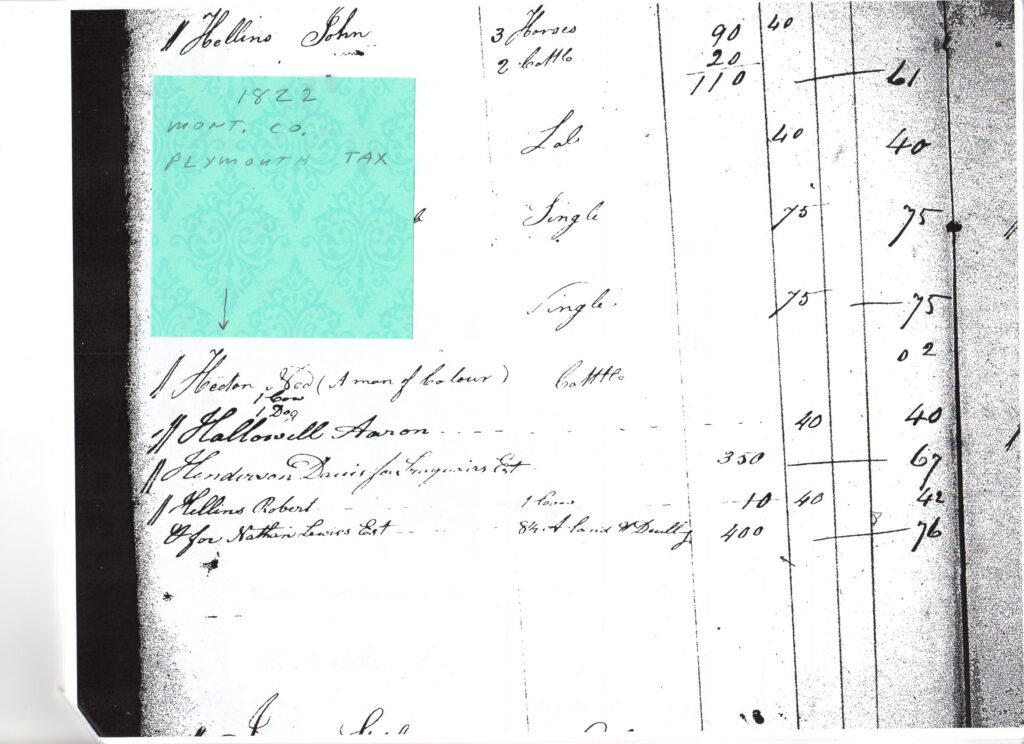




Ned Hector’s Cabin Location
Ned’s cabin location can be determined by the following pieces of information:
- According to Theodore Bean in 1832, before Conshohocken becomes a corporate entity, there are six homes located in Ned’s area.
“The First Ward in 1880 contained 1726 inhabitants, and the Second 2835. The place in 1832 contained only 1 store, 1 tavern, a rolling-mill, grist-mill and 6 houses; in 1858, 4 taverns and 22 stores; the census of 1860, 323 families and 324 houses. The manufacturing establishment in 1870 were 4 rolling-mills, 3 furnaces, 1 cotton-mill, 1 print-works and a woolen-mill.”
Bean, Theodore W., History of Montgomery County, 1884. pp.713.
- According to the Federal census Ned is living in the area 1800 to 1830.
- Ned is paying taxes in Plymouth Township until 1825.
- According to Theodore Bean, one of the places reported to have built over Ned’s cabin was William Sommers’ Store in 1832.
“In 1832, where is now the large store of William Sommers, corner of Fayette and Hector Streets, stood a cabin in which had lived for some time a colored man called Ned Hector, who had been a team-driver for the army in the Revolution. On laying out the town it thus came that a street was named after him. He died January 3, 1834, aged ninety years, and his wife, Jude, two days thereafter.”
Bean, Theodore W., History of Montgomery County, 1884. pp.102-118.
- There is a map close to the period of time [William E. Morris -1848] showing the locations of some of the homes.
- On this map Harry, Foulke, Jones, and C.M. homes can be located. That leaves two homes under the “h” and “o” of “Conshohocken”.
- From Bean’s above statement, if Ned’s cabin was where Sommers’ Store was it would have been at the intersection of Hector Street and Fayette Street or at the time the Plymouth-Whitemarsh Turnpike.
- There is only one house located next to the Plymouth-Whitemarsh Turnpike on the western side.
